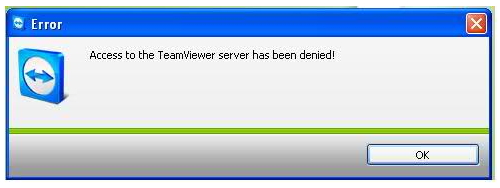
No Connection To Teamviewer Server
SOLVED Not able to connect to TeamViewer This is a discussion on SOLVED Not able to connect to TeamViewer within the Windows 7, Windows Vista Support forums, part of the Tech Support Forum category.
Here's a familiar yet nightmarish scenario: you've burned the midnight oil to write up that report your boss has demanded for first thing in the morning, but when you get to work you discover you've left the file on your PC's desktop. What should you do? Resign, plead for mercy or just run?Well the answer - if you've got a piece of software called TeamViewer installed on your PC - is relax.TeamViewer is a clever and very powerful program that will let you take remote control of a PC over the internet. This makes it ideal for retrieving forgotten files, and it's also a great way of helping friends and family with their computer problems without leaving the comfort of your desk.If you're a home user you can download and install the software for free. For business use, see the.
As you read on we'll discover how to rescue that forgotten file and also how to take remote control of your desktop PC. Here's how to do it. Step-by-step: Get files from your PC remotely1. Grab the softwareTeamViewer is like a telephone conversation made between two PCs, so both machines will need to have the software installed. We're going to assume you've a main desktop PC and a laptop that you take out and about with you. To get started, download TeamViewer on your desktop PC from.2.
Get configuredNow click 'Run' at the bottom of the screen and, when prompted, accept the license agreement. You'll need to check the two tick boxes here as well. Finally, when prompted, choose 'Personal/ non-commercial use' and click 'Next'. The next screen is called 'Set up unattended access'.
All you need do is click 'Next' to proceed.3. Make an accountOn the next screen, you'll need to give your computer a password. Application will be terminated. Once you've chosen one, click 'Next'. On the following screen you'll be asked to provide your email address and a TeamViewer password; make a note of this password, because you'll need it later.
This page has been transferred to the Audacity Manual - see Preferences in the Manual for current Audacity. How to reset audacity settings to default. Anything you do in audacity can be undone, so just mess around with settings until you find something that sounds good. If you get too much random noise in the background after boosting your gain/compressing you might want to use the built in Noise Removal plugin. Jump to: navigation, search. From Audacity Wiki.

Click 'Next' when you're done.4. Activate your teamYou will now see a screen that looks like the one above. Don't worry about the passwords at this point - we'll use those later. Your final job is to access your email inbox and find a message from TeamViewer.
You'll need to open it and click on the long link, which will activate your TeamViewer registration.5. Set up your laptopNext, it's time to fire up your laptop and install TeamViewer there, too. When you're done, you'll need to follow the same steps as before until you reach the screen above. This time, select 'I already have a TeamViewer account' and enter the email address you registered with, along with your TeamViewer password.6.
Take controlLet's be adventurous and give full control of your desktop to your laptop. Looking at your main PC, note down the number next to 'Your ID'.
Now, working on your laptop, enter this number into the 'Partner ID' box. Click 'Connect to partner' and enter your TeamViewer password. You'll see your desktop PC's Windows desktop appear.7.
Access your PC remotelyWorking on your laptop, you should now be able to move icons around on your other PC. You can open programs, close programs and make system configuration changes too. In this mode, TeamViewer is also ideal for troubleshooting PCs remotely. Set it up as before and you'll be able to help your friends without leaving your own home.8.
Retrieve that fileIf you've forgotten to transfer a file from your desktop, close the windows that control your other PC, then look under 'Control remote computer' in the TeamViewer display. Select 'File transfer Connect Log on'.
Navigate to your file and select it. Click 'Retrieve' and it will be transferred to your laptop's My Documents folder.
I'm using Fedora Linux, and successfully installed teamviewer11.0.67687.i686.rpm. But I'm getting a dialog 'No connection to TeamViewer server. Please check your internet connection. Most likely you use a proxy server and you have to enter the proper information in the options dialog.' It doesn't work for me, also Fedora 25.$./teamviewerInit.CheckCPU: SSE2 support: yesXRandRWait: No value set. Using default.XRandRWait: Started by user.Checking setup.Launching TeamViewer.Starting network process (no daemon)/home/xxxx/Downloads/teamviewer12.0.71510i386/teamviewer/tvbin/teamviewerd: error while loading shared libraries: libdbus-1.so.3: cannot open shared object file: No such file or directoryNetwork process already started (or error)Launching TeamViewer GUI.Then, have a small window pops out shows error and black content. Well, for those having problems even with the tarball, I just discovered that it wil not work if you install the tarball (tv-setup install), but it will if you run directly the teamviewer executable in the folder where you extract the tarball.From what I can see, the difference is that a so-called 'Network process' is not started when you run it from the installed version while it does start if you run teamviewer directly from the folder where you extract the tarball.
More than a Wayland problem this seems like a permissions problem when you install under Wayland.